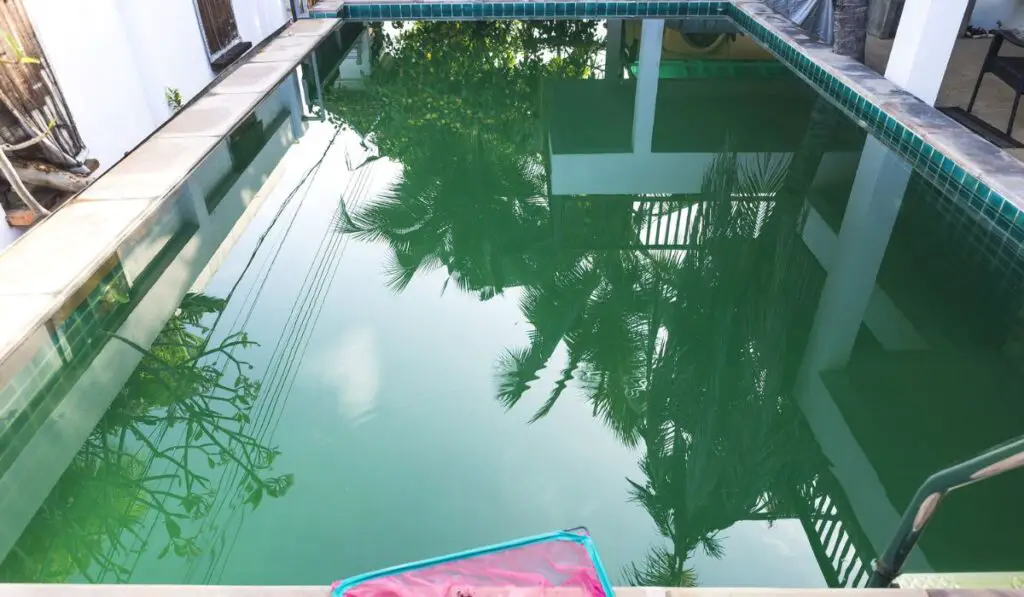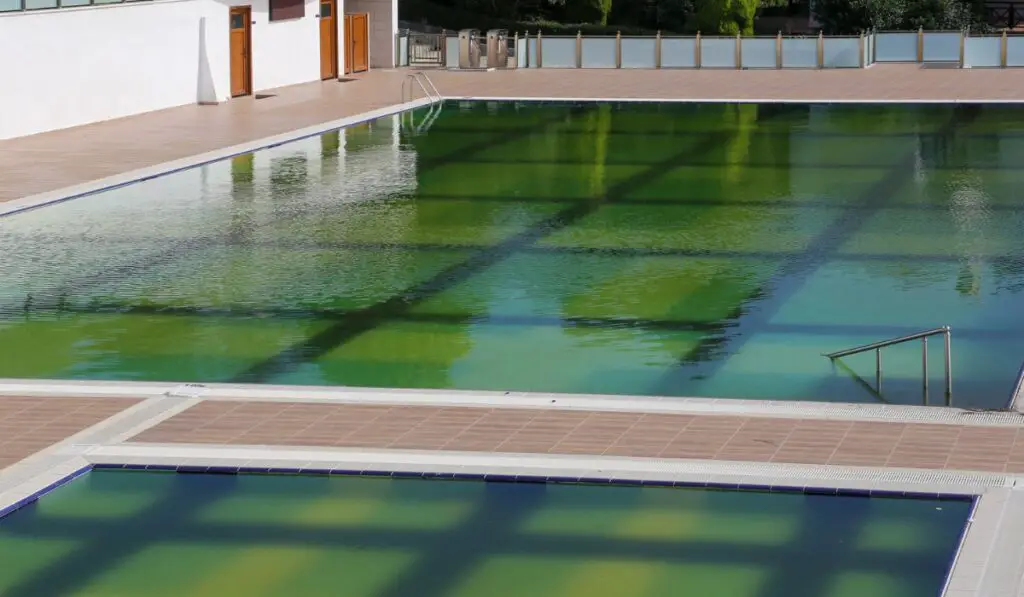Cleaning a green pool is extremely easy and doesn’t require draining the pool or completely starting over. However, the process is a bit lengthy, and it will take around four to five days for your pool to return to its crystal-clear state.
You can clean a green pool by removing the large debris with a leaf net, testing and adjusting the water’s chemistry, and then shocking the pool. Make sure you also add an algaecide and clean the pool’s filter. Vacuuming your pool weekly can prevent it from turning green as well.
You can also prevent your pool from turning green by performing bi-weekly or weekly maintenance and regularly hiring a pool service company for professional pool cleaning. Let’s look at why your pool turns green, how to fix it, and whether you can swim in a green pool so you can go back to swimming in clean, algae-free water in no time.
Why is Your Pool Green?

Your pool usually turns green because of pool algae. If the water in your pool is a light green, the algae probably just started to grow and spread. However, if it’s a deeper green, you have a much bigger and more severe algae bloom problem.
Green algae growth occurs when your pool’s chlorine or sanitizer levels are too low. Heavy rain, poor circulation, and exposure to extreme heat also increase the risk of pool algae growth, especially if you don’t use a preventative algaecide. Luckily, it’s straightforward to treat and even prevent this problem.
How to Clean a Green Pool
The fastest and most effective way to clean a green pool is by adding pool chemicals and running your pool filter. While it will take around four to five days for the algae to disappear completely, you’ll start noticing a significant improvement only after 24 hours. Here are the steps you need to follow:
Step 1: Remove the Large Debris
Check the bottom of your pool for large debris and remove it with a leaf net (on Amazon). It’s advisable to avoid using a skimmer, as it will only stir up the pool water and make it look much worse than it previously was.
Remove the debris as gently and carefully as possible, and avoid stirring up the water. If you can’t see the bottom of your pool, ensure you don’t vacuum it. Vacuuming will only damage or clog the filter, underground plumbing pipes, and skimmer.
Step 2: Adjust Your Pool’s Chemical Levels
Test your pool water and adjust its alkalinity and pH levels by adding pH minus (on Amazon) and Alkalinity Plus (on Amazon). Maintaining your pool’s chemical levels within a specific range is essential, or you’ll never have crystal-clear water.
Make sure you specifically check the water’s pH, cyanuric acid, and free chlorine levels and ensure they’re within the following ranges:
- pH level: 7.5 – 7.8
- Cyanuric acid: 30ppm – 60ppm
- Free chlorine: 3ppm – 7ppm
If your pool water’s chemistry is imbalanced, add the appropriate chemicals (soda ash, muriatic acid, cyanuric acid, etc.) to rebalance it.
A pool chemistry calculator is also advisable to determine the best dosages to rebalance your pool effectively. Additionally, ensure you wear protective gear, such as gloves and goggles, when working with all these pool chemicals.
Step 3: Shock the Pool Water
Shocking your pool water simply means over-chlorinating it. The process involves adding up to five times the average amount of chlorine in the water, effectively killing the algae and bacteria and turning your pool green.
It’s best to shock your pool at night. If you add pool shock while the sun is still out, the water’s chemical levels will be negatively affected, resulting in much costlier problems.
Choosing the Right Shock Type
There are two types of pool shock: powdered and liquid shock. If you use a powder shock (on Amazon), you’ll need to add more water to your pool. For example, for each pound of pool shock you add, you’ll need to add five gallons of water.
Ensure you also correctly stir the water and shock mixture until there aren’t any granules left. Remember that if the mixture still has granules, they’ll sink to the bottom of your pool and ultimately damage it.
Liquid chlorine (on Amazon) is much simpler to use, as you just need to pour it into your pool. Make sure you spread it all around your pool, and don’t just pour it all in one spot. Keep adding liquid chlorine for a few days until the water starts changing from green to a cloudier white.
You can even add liquid shock to your pool’s filter system to clean it and disperse the chemical throughout your pool. However, make sure you never swim in your pool after shocking it. Wait a couple of days and only jump into the water again after it’s completely clear.
Step 4: Add an Algaecide
While all algaecides prevent and treat pool algae, it’s important to note that each algaecide is formulated differently. So, choose an algaecide that eliminates green pool algae if you want to clean a green pool.
After adding algaecide, it’s also essential to thoroughly brush the surface of your pool to get rid of any dead algae that might still be in it.
Step 5: Clean the Filter
Chemically clean or backwash your filter by following the instructions in the owner’s manual to remove any mineral and organic build-up.
Ensure you also continuously run your filter and pump for 24 hours after cleaning, so all the water in your pool passes through the clean filter at least once.
Step 6: AfterCare
Once you’ve cleared most of the algae from your pool, you’ll notice some dirt and debris at the bottom. If there’s only a tiny amount of debris or contaminants, you can scoop it up with a skimmer or run a pool vacuum across the bottom.
If there’s a lot more debris than you can vacuum or skim, it’s better to hire a certified pool technician to clean it properly. This will prevent clogged pipes and save your pool’s filter from any additional damage.
Can You Prevent Your Pool from Turning Green?

Cleaning a green pool is a long and tiring process of testing and shocking, so it’s best to prevent it from turning green in the first place. Luckily, there are several things you can do to keep the water in your pool fresh, clean, and crystal-clear, such as:
- Vacuum the pool weekly.
- Regularly swim in your pool to prevent stagnant water.
- Test your pool’s free chlorine, CYA, and pH levels weekly.
- Add pool chemicals as required.
- Check your filter and backwash it as needed.
- Brush the walls of your pool.
- Regularly clean the skimmer.
- Run the filter for at least 10 to 12 hours every day.
Is it Safe to Swim in a Green Pool?
It’s not safe to swim in a green pool. While the algae itself isn’t harmful, all the bacteria that thrive with it are dangerous. And when you swim in a green pool, you expose yourself to all these bacteria, which could result in bacterial infections.
You could also get sick if you swallow algae-filled water. Algae is incredibly slippery as well and could cause serious falls and injuries.
A green pool even increases drowning risks. This is because algae negatively affect your pool’s clarity, making it extremely difficult to see if someone’s struggling. However, the good news is that it’s extremely easy to clean your green pool and return it to its crystal-clear state.
